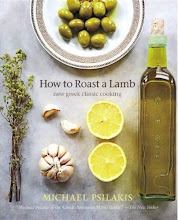 Not too long ago, dear friends took me to dine in a resto in the Seventh Arrondissment named Le Violin d’Ingres, owned by Chef Christian Constant. There I was served a crunchy sliced baguette with thick pats of rich French butter that was topped with pepper, crunchy fleur de sel (Brittany sea salt) and ground allspice. The famous food writer Patricia Wells had dined here, as well, and dubbed this dish “rue Saint-Dominique Caviar as the resto is located on 135, rue Saint-Dominique.
Not too long ago, dear friends took me to dine in a resto in the Seventh Arrondissment named Le Violin d’Ingres, owned by Chef Christian Constant. There I was served a crunchy sliced baguette with thick pats of rich French butter that was topped with pepper, crunchy fleur de sel (Brittany sea salt) and ground allspice. The famous food writer Patricia Wells had dined here, as well, and dubbed this dish “rue Saint-Dominique Caviar as the resto is located on 135, rue Saint-Dominique.
I like this appetizer so much, I wanted to try it, (with my own slight interpretation) when I invited friends to my Paris appartement for aperitifs.
Here is my take on this simple appetizer I call rue des Petits-Champs “Caviar” as I first made it in my Paris appartement located on that rue.
I used very thinly sliced baguettes and very thinly sliced unsalted French Echire cows-milk butter (but any unsalted butter sliced very thin works fine).
(FYI: French butter must be at least 80 percent fat and not more than 15 percent water. The remaining five percent or so is made up of milk solids and in salted butters, salt. French and French-style butters just have a higher percentage of fat than mass-produced American butters.)
I put all the black Tellicherry peppercorns, white, pink and green peppercorns and whole Allspice in one peppermill set on coarse grind and lightly dust the buttered slices. In a
small bowl, I a mixed equal parts of black Kilauea sea salt, pink Australian sea salt, and white flake sea salt from Cyprus. Sparingly I sprinkled pinches of the salt over the buttered slices. This crunchy, salty, sweetly-creamy, and spicy combination of textures and flavors wakes up your palate...so simple, yet unexpected. Also unexpected is how festive this effortless fare looks on the plate. The colorful salts, peppers and spices resemble miniature confetti.
This crunchy, salty, sweetly-creamy, and spicy combination of textures and flavors wakes up your palate...so simple, yet unexpected. Also unexpected is how festive this effortless fare looks on the plate. The colorful salts, peppers and spices resemble miniature confetti.
This dish is wonderful accompaniment to a fresh green salad as a first course.
That day that I first tried making this, I served it using small slices of toasted baguette with assorted green, black and purple olives and cornichons, (a small vinegary dill pickle) for my aperitif soirée at rue des Petit-Champs. I was relieved that it was a success... I thought that you might enjoy this image as an accompaniment to the appetizer recipe…
I thought that you might enjoy this image as an accompaniment to the appetizer recipe…
It is a view down rue St-Dominique where I lived a student at École Nationale Supérieure des Beaux-Arts. The signage is of resto Thomieux across the rue.
I could always tell when dinner service was about to begin, when the smells of garlicky escargot and sounds of clinking dinnerware pervaded my tiny garret as I studied.
Saturday, August 30, 2008
rue des Petits-Champs “Caviar”
Tuesday, August 26, 2008
Lemon-cream dream…
This afternoon I just finished painting the walls with a fresh new color. The paint color took a long time in the choosing, back and forth with sample paints, trying them on the walls that get sun and those that are always in shadows. I can tell you that many, MANY hours were spent in choosing just the right hues and tones. (Life can throw you many a curve, but there is always color choices that can help to take you mind off the curvy-ness and set you right for a bit.)
Finally, after making friends with nearly every person at the paint store, I chose two shades of paint in creamy tones, one neutral and one that reminds you of a soft lemon-cream.
(Yes, OK, so my foodie persona does spill over to my architect-designer side…)
Two walls receive very little light, so those I painted them with the lighter neutral tone and the wall that gets the lovely morning sun, in a slightly more lemony shade that bounces the sun to other two walls. (Yes, there are four walls, but one wall is primarily walk-in closets with dark doors. But this contrast give the room a nice balance and warmth.)
I have to say that my paint trial were so far a success...
The effect of morning light on lemon-cream will be an energizing way to begin my day.
And tonight , with the the soft light of the tall paper-shaded Japonaise lamps, (I bought on sale at IKEA), the room softens to a pearl-hued haven to welcome my weary bones to rest.
After the painted walls were dry, I hung airy new crème brûlée toned curtains that I hope will let in the the right amount of lighting in the morning and yet keep me secluded in the evening. The drapes looked so lifeless in their plastic sacks, but emerged as ethereal beings to add their charm to the atmosphere that I am working to create.

Tomorrow, I await the carpet cleaning dudes to work their magic.
I have high hopes that they will revive my two year-old rug from a semi-sad mottled moppet back to the former soft and svelte créme fraîche perfection under my feet.
Then, the long awaited arrival of the sleek, dark licorice oriental charms of the Japonaise styled bedroom furniture. In essence, it will appear, in its furniture sense, much like this image I am posting from the furniture showroom. But that image is cooler, more perfect and more sophisticated than I tend to be. I want to warm this sleek, chic image with my own personality and eclectic flavors.
But, after all, the furniture will be just the basic hardware around where I will finally make this truly a room of my own…a home.
P.S. I promise to post an image of the real finished space as soon as I am able.
And then, I will get back to the food…
I know that you are just all here for the food.
Merci beaucoup, to you all for listening to my design musings.
The good doughnut...
 Chinese orchard farmers treated peaches with such reverence that they could be planted only within the royal precincts of the emperor. Their peaches were classified in one of two ways: golden with yellow flesh and silver with white flesh.
Chinese orchard farmers treated peaches with such reverence that they could be planted only within the royal precincts of the emperor. Their peaches were classified in one of two ways: golden with yellow flesh and silver with white flesh.These beautiful silver, intensely flavored and odd-shaped peach we now know in the United States as the ‘Saturn’ peach were called the pan tao in China. They are lower in acidity, sweeter than yellow peaches and with a slight almond undertone in the taste.
 The Saturn peach simply taste better than other varieties and they are easier to eat on the run. The fruit’s thin red skin has little or no fuzz so it doesn’t have to be peeled and the small pit can be popped out quite easily. In season, they are my favorite on the go lunch as I drive from errand to errand.
The Saturn peach simply taste better than other varieties and they are easier to eat on the run. The fruit’s thin red skin has little or no fuzz so it doesn’t have to be peeled and the small pit can be popped out quite easily. In season, they are my favorite on the go lunch as I drive from errand to errand.They have also just found their way into my humble cooking repertoire as a compnent in a sweet-spicy sauce for okra that I served last night with lean grilled chicken breasts.
It seemed like an unlikely paring, indeed, but the combination of the nutty sweetness, spice and Farmers Market fresh okra made for a wonderful taste, quite different from the ordinary.
I promise to post the recipe as soon as I determine the quantities, as made this sauce by taste.

Monday, August 25, 2008
Paris in the park...
This Bakery is one of the Urban Vendors that are committed to the mission of the Market to improve the availability of a diverse range of high quality foods. This wonderful bakery
produces croissants, scones, baguettes, pastries, cakes, cookies and artisanal breads
with organic ingredients.

The Coupe du Monde de la Boulangerie is an international artisan bread baking competition held every three years in Paris. It is the world’s only competition where bakers who practice the craft of artisan baking can compete against the many old-world traditions of the various countries involved. The purpose of the competition is to gather artisan bakers from around the world to celebrate their profession, share knowledge of artisan baking techniques, and reinstate the value and restore the image of the artisan baking profession.

But I don't want to be too cruel...
These images I have posted of Bennison’s stunning wares are cruel enough, I fear.
On this pleasant summer day, I had a lovely taste-trip to Paris without ever having to go through airport security.
If you live in this area, please visit Bennison’s Bakery at their Evanston location or at Chicago Green City Market.
Saturday, August 23, 2008
French breakfast radishes
You have to agree that their beauty en mass is indeed a show stopper at the Farmers Market.
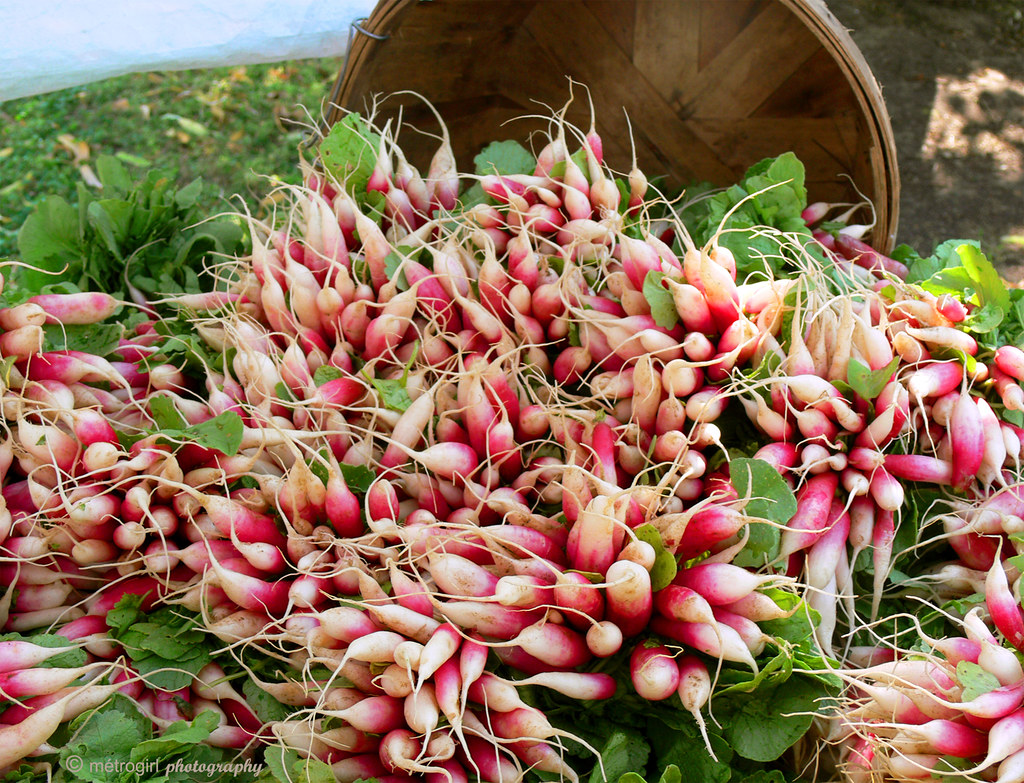 This root vegetable is related to the turnip and horseradish family, with a crisp texture and a mild to delicately sweet flavor. The French Breakfast radish has an elongated shape that can grow to approximately three inches in length, displaying a lovely pink-rose outer skin, which turns white at the root base.
This root vegetable is related to the turnip and horseradish family, with a crisp texture and a mild to delicately sweet flavor. The French Breakfast radish has an elongated shape that can grow to approximately three inches in length, displaying a lovely pink-rose outer skin, which turns white at the root base.
As a child, I recall that my mother used this radish to make small hors d'oeuvres, that she served with aperitifs. She sliced them thin and layered the radishes on a crusty baguette spread with fine quality French butter and sprinkled with sel gris. But as an adult, accustomed to moderating my fat and sodium intake, I love the texture and flavor that these particular radishes add to a simple summer salad.
I start with heirloom tomatoes, sliced in chunks; small carrots, julienned; the French breakfast radishes, sliced thin, and a mix of fresh lettuces. I drizzle extra virgin olive oil, a dash of good balsamic vinegar and toss all ingredients.
Sprinkle with sel gris, or sea salt, and several grinds of fresh ground white (or black) pepper.
Et viola…!
I did not state exact proportions for this recipe, as I make it to taste and it varies slightly each time. You can modify the proportion of each ingredient or add other favorite ingredients to your taste, while summer veggies are fresh and readily available…
Bon appetit…!
Friday, August 22, 2008
the versatile daikon radish
The name of the Daikon radish comes from the Japanese word dai (large) and kon (root). This sensual white vegetable is a large Asian radish with a mild and sweet fresh flavor. The flesh of the daikon is white, crisp and juicy, while the skin can either be creamy white or black.
It can range form 6 to 15 inches in length, to a diameter of 2 to 3 inches.
When shopping for this beauty, choose those that are firm and unwrinkled.
Refrigerate wrapped in paper toweling and then very loosely in a plastic bag.
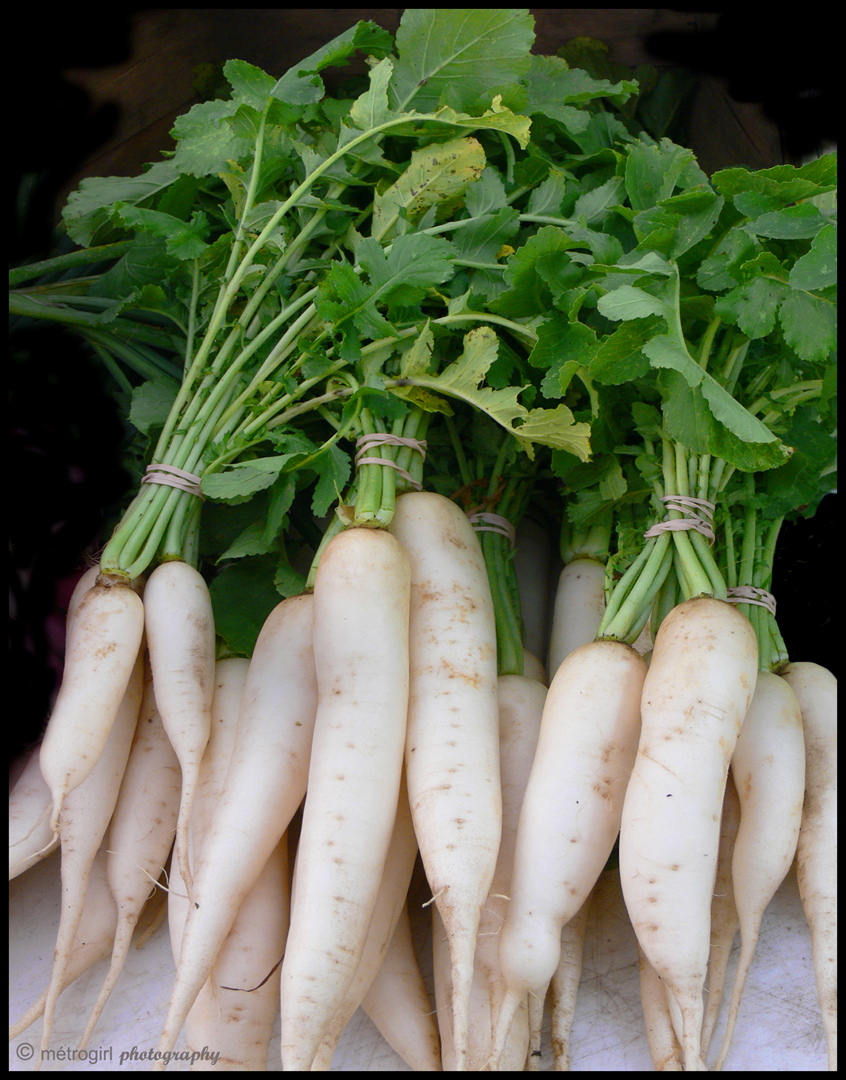 The daikon radish is an important part of Japanese cuisine..
The daikon radish is an important part of Japanese cuisine..Raw daikon may be served in salads, as a garnish for dishes such as sashimi, or marinated in vinegar. Grated raw daikon, known as dailon oroshoi, and is popular as a garnish garnish for dishes such as yakizakana ( grilled fish), natto, or in the dipping sauce for tempura or soba. Cooked daikon is often served as an ingredient in miso soup or in stews such as oden.
I choose these beautiful specimens at the Green Acres Farm’s stall at Chicago Green City Market. I am looking forward to trying some new recipes with these stunning Daikon radishes.
For an interesting way that Chef Laurent Gras of restaurant L.2O cuts these radishes...
Thursday, August 21, 2008
feeding my head...
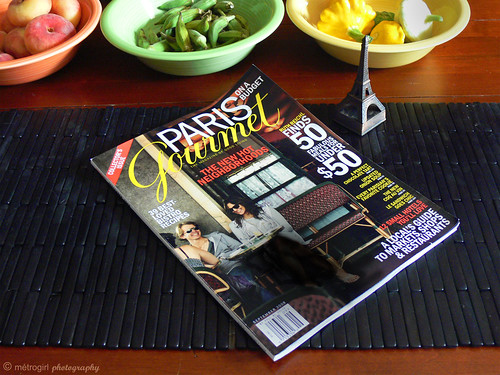
The arrival of my September issue of Gourmet Magazine was bitter-sweet as it is dedicated to Paris food. Usually each year I spend September and October in my real home in Paris. I do so look forward to being with friends and family, wandering all the places I adore and finding out what is new and chic in the land of trés, trés chic. And naturellement, sampling the fabulous and picture perfect food.
Alas, this year due to personal reasons I will just be reading about Paris and the stunning and delicious food around every corner.
After I feed my head…and my heart…
Wednesday, August 20, 2008
otom…dining in the mirror…part deux
We were drinking cool bubbly waters, fruity wines, ancient beers, munching crusty fresh breads, with homemade butters. We were of course talking about food with each other, the superb chef and his fine staff. But there is so much more yet to tell.
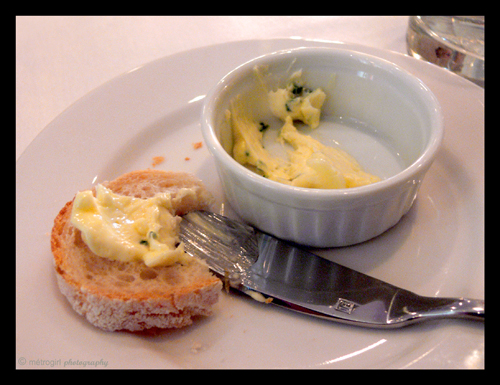 All the members of our group commented on the how the design of the restaurant’s interior was very conducive to a feeling of relaxation, yet imparted a loft-like chic that made one feel that you are in a very special environment. Drawing on my experience as a design professional, I was interested in their feed back. Of particular note were two design elements that all thought worked wonderfully.
All the members of our group commented on the how the design of the restaurant’s interior was very conducive to a feeling of relaxation, yet imparted a loft-like chic that made one feel that you are in a very special environment. Drawing on my experience as a design professional, I was interested in their feed back. Of particular note were two design elements that all thought worked wonderfully.
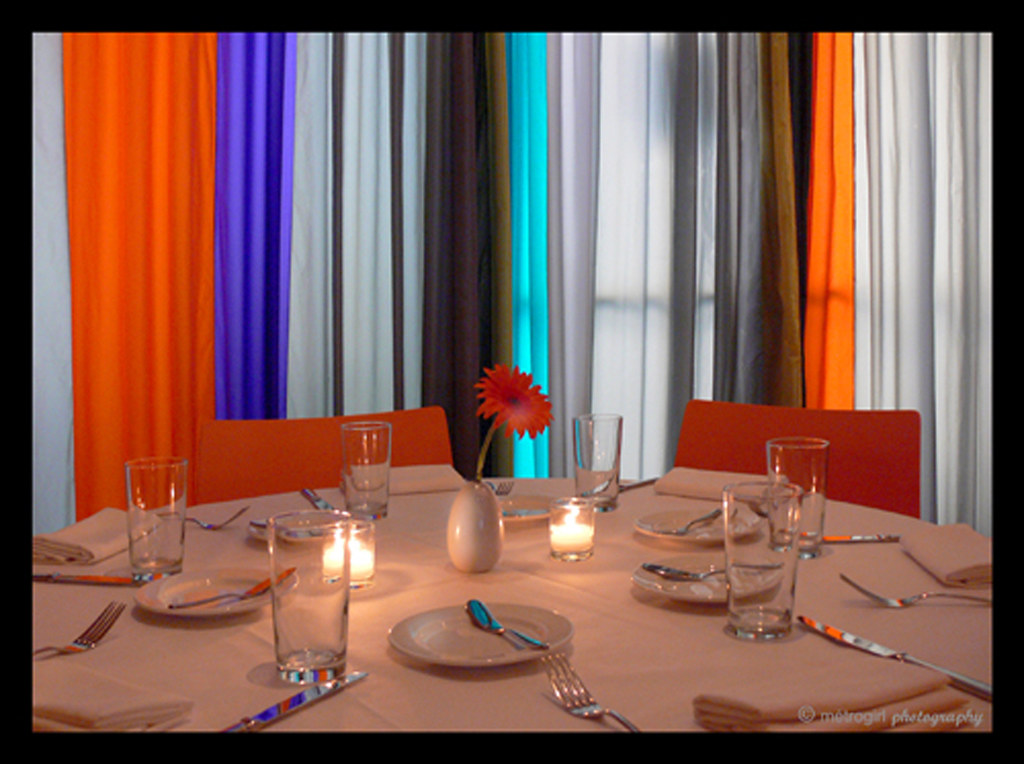 The first was the floor to ceiling Paul Smith inspired colorfully striped parachute fabric drapes. In the warm daylight they imparted a lovely cooling environment and as evening fell, the silk caught the candle glow creating a warm and intimate atmosphere.
The first was the floor to ceiling Paul Smith inspired colorfully striped parachute fabric drapes. In the warm daylight they imparted a lovely cooling environment and as evening fell, the silk caught the candle glow creating a warm and intimate atmosphere.
All agreed that the second design element that was very successful were the molded plastic tangerine chairs surrounding the pristine white-clothed tables. At first glance, they appeared a bit stiff (read totally uncomfortable...). However these colorful chairs proved to be the ultimate in comfort. They are called the “minx” and were designed in Italy by Casprini Gruppo Industriale. The name is also appropriate, as “minx” is an old English word that meant conversation and we did indeed have long lovely conversations in complete comfort seated on the minx.
Interior architect and designer Michael Richman incorporated so many well thought out design details in this interior. They all came together to create the chic sophisticated loft ambiance with that pop of playfulness that kept the space from feeling too stuffy.
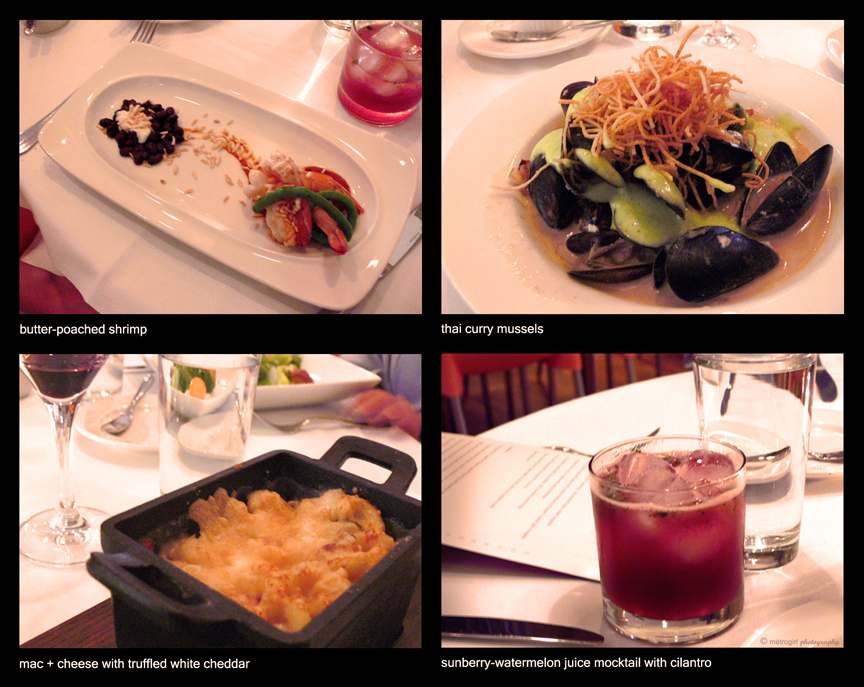 Although Otom is the sister resto of Moto, like all siblings, she has her own distinct and striking personality. Otom is about choices. and choose we did. Since we had a party of five, as a group we decided to each get a different dish for each course and share the love.
Although Otom is the sister resto of Moto, like all siblings, she has her own distinct and striking personality. Otom is about choices. and choose we did. Since we had a party of five, as a group we decided to each get a different dish for each course and share the love.
Some of our appetizers include succulent Butter Poached Shrimp with black beans and chili with puffed rice and a surprise, a green but deliciously spicy jalapeño noodle.
I choose the Thai Curry Mussels with snap pea froth and coconut sauce. That sauce was so flavorful, that everyone at the table used their bread to get the last savory drop.
The traditional comfort food, Macaroni and cheese was elevated to comfort chic with the addition of truffled white cheddar and double-smoked bacon and chives. That was a great favorite at our table and was passed around until the cast iron dish was scrapped clean.

For our entrees, unbelievably had no squabbles about each choosing a different dish as there were enough interesting choices to please each individual palate.
The oldest member of our party choose the somewhat traditional Braised lamb shank with white bean cassoulet, rutabaga and olive oil. She love every bite and that is high praise for a woman that has been a connoisseur of lamb for 80+ years.
We were all intrigued to see and taste the Fried short rib ravioli, and it particularly appealed
to that carnivore that ordered it. Beautifully formed and perfectly fried ravioli (with no trace of greasiness) appeared on a sweet and savory parsnip and vanilla purée with a very generous sprinkling of sweet potato butterscotch brown butter powder.
Now how cool is that…?
Needless to say, everyone enjoyed their taste of this dish.
As always, I chose a fish dish.
The Seared cod was perfectly done. It was presented on a bed of bright crimson lentils, rapini and a miniature sculptural patty-pan squash. Chef Daryl Nash elevated this simple dish to elegance by the addition of semisolids, one tasted of citrus and one had the flavor of capers.
I loved this dish so much and took si much time tasting it as I ate in hope to replicate it at home. I tried this dish from my food memory three times and I have to say I got close, very close. However, I didn’t have the magic of all the flavors and geometry of the semi-solids, or the charisma of Otom in general.
 It is no secret in my family that my beautiful 13 year-old niece has a particular weakness for sweets. So we gave her carte blanche to choose 2 desserts if she desired…
It is no secret in my family that my beautiful 13 year-old niece has a particular weakness for sweets. So we gave her carte blanche to choose 2 desserts if she desired…One of her choices won her heart completely...simply Milk ‘n cookies…
She was presented by the chef, no less, with two huge (5” in diameter) chocolate chip cookies on a mascarpone and caramel banana bed, topped with vanilla wafer ice cream. Pastry Chef Natalie Oswald’s desert concept hit a definite a home run with my niece with this plate.
The Coconut-pineapple paradise dessert called to the south sea traveler in on person.
It came complete with an inverted pineapple, sand dunes, coconut lotion and a piña colada with a colorful umbrella for shade.
For myself, thinking architecturally, I choose the Key Lime Forms.
This was the perfect finish for my palate. A pie with a perfect and well “tanned” meringue, a deliciously tart sorbet, a sweet lime semisphere presented on an elegant spoon resting on a crumble. I was so sorry to see that this was the hit of the table and was gone long before I really dug in…bummer.
But, that another great reason to return to otom before Chef Nash changes to his autumn menu.
 For those of you that live in this area or are planning a visit to Chicago,
For those of you that live in this area or are planning a visit to Chicago, 951 west Fulton Market Street, just 5 minutes west of the loop.
312.491.5804
I promise you, you will not be disappointed, and will feast on more than mere pixels.
Tip: Make a reservation for an early dinner during a weekday.
Monday, August 18, 2008
otom…dining in the mirror…part une

I had heard that Otom had a delectable fare of contemporary cuisine and a touch of molecular gastronomy that keeps the diner's palate entertained and satisfied.
The Executive Chef Daryl Nash conjures delicious, elegant, artistic and surprising plates with flavors to delight all your senses. I was intrigued…
My visiting family and I arrived early for our reservation time as we came directly after the afternoon matinee of the musical Wicked at Ford Theater. We were given a very warm welcome immediately by a very personable young woman that showed us to the lounge area. The plush Paul Smith inspired striped seating, pops of a combination of sunny and cool colors and the clean loft styling was a refreshing haven on that hot August day.
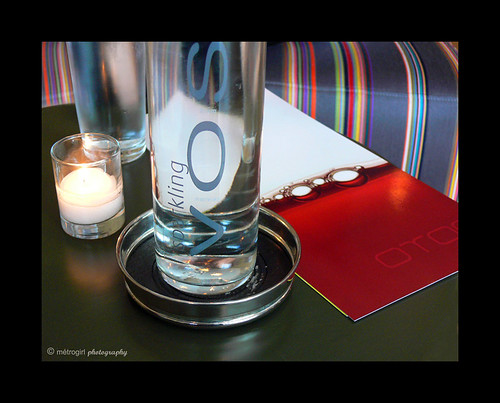 Although we were quite early, the maître d' welcomed us to take our table, but we decided to order some refreshments and relax in this lovely cool contemporary lounge atmosphere as we waited for the reminder of our party to arrive. The waitress and mixologist advised us on our choices of beverages (that were endless) took our orders.
Although we were quite early, the maître d' welcomed us to take our table, but we decided to order some refreshments and relax in this lovely cool contemporary lounge atmosphere as we waited for the reminder of our party to arrive. The waitress and mixologist advised us on our choices of beverages (that were endless) took our orders.Our preferences included Voss, a sparkling artisanal water sourced from the south coast of Norway, a Syrah from New Zealand, and a very special Sunberry-Watermelon ‘mocktail’ for my sweet 13 year old niece.
One person in our party is an avid beer aficionado and was offered a special beer named ‘Nora’. This special brew has been concocted from an ancient Egyptian recipe. Unmalted kamut which was used in ancient Egyptian beers is employed. Hops, which would not have been used in Egypt, are employed in a tiny quantity, solely for their preservative power. Rather, ginger, myrrh, and orange peel are used to represent the balancing spices of ancient times. The myrrh provides the bittering that allows the brewer to mostly forgo the use of much hops.
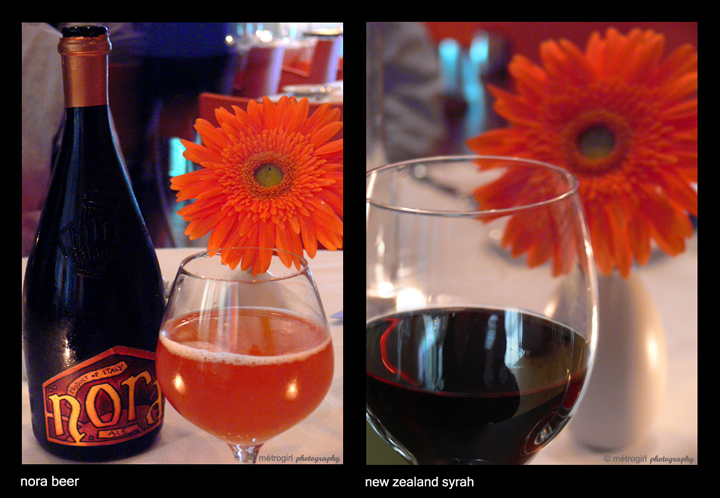 When our libations arrived they were so lovely that I naturally had to photograph them, but first asked permission from the waitress. I told her that I was had a brand new food blog and would love to write about the restaurant, the cuisine and the chef, about whom I had heard so many positive reviews. Not only did she assent, but brought Chef Nash out to meet us.
When our libations arrived they were so lovely that I naturally had to photograph them, but first asked permission from the waitress. I told her that I was had a brand new food blog and would love to write about the restaurant, the cuisine and the chef, about whom I had heard so many positive reviews. Not only did she assent, but brought Chef Nash out to meet us. As the remainder of our party joined us we were escorted to our table, seated with aplomb (with hooks for our purses…) and settled in to discover what tricks Chef Nash had up his sleeve to please our many varied palates.
As the remainder of our party joined us we were escorted to our table, seated with aplomb (with hooks for our purses…) and settled in to discover what tricks Chef Nash had up his sleeve to please our many varied palates.Just minutes after we were seated, Chef Nash and our waiters presented us with the amuse bouche and explained the culinary vision for this small taste of summer.
The chef explained that was this was ‘watermelon Toro’, Toro is the belly meat of tuna, and this dish comes from the ‘belly meat; of the watermelon. I loved the conceptual thought on this presentation…
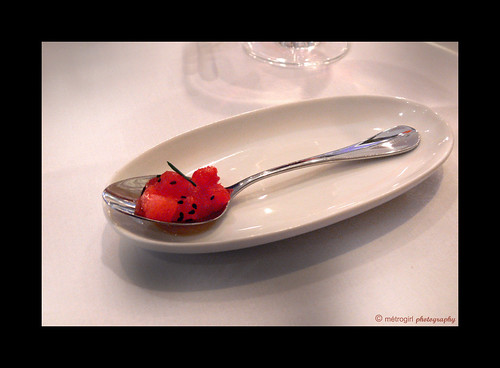 The fresh watermelon was then carbonated, sprinkled with black sesame seeds, chives, and plated on an elegant spoon on a pure white dish. Under the spoon was a delicious spiced root vegetable purée, It warm spicy flavor was a perfect contrast to the cool watermelon burst in your mouth.
The fresh watermelon was then carbonated, sprinkled with black sesame seeds, chives, and plated on an elegant spoon on a pure white dish. Under the spoon was a delicious spiced root vegetable purée, It warm spicy flavor was a perfect contrast to the cool watermelon burst in your mouth.This was so appealing, both in its aesthetic presentation, and that the chef used fresh ingredients, in season and then spun his culinary magic to make the simple summer staple sparkle in your mouth.
This was a wonderfully refreshing way to begin a mea and a conversation with the food at Otom on a hot summer evening.
The amuse bouche was simply elegant and elegantly simple.
I say this not for lack of words, but because it was the perfect opening with the perfect presentation to what was to come next.
Tomorrow… otom…dining in the mirror…part deux…
Saturday, August 16, 2008
Adventures with the tomato…Part IV...the tomato at sea…

Scanning a list of recipes, I see Shrimp Cacciatore, Shrimp Creole, Tomato Shrimp brochettes with Tomato-Basil Champagne Sauce, Seafood Paella, Angel Hair Pasta with Tomato Shrimp Cream Sauce, Bahian Shrimp Stew with Coconut and Tomato, Shrimp Poached in Tomato-Tarragon Sauce, Barbecued Shrimp Skewers with Sun-Dried Tomato Basil Aioli, Tomato Florentine soup with Shrimp, Shrimp in Saffron and Tomato Broth, and Shrimp Gumbo; as you can see this list is truly endless and only limited by the imagination and daring of the cook.
To quote a much loved character, Bubba Blue from the movie Forest Gump:
“Shrimp is the fruit of the sea.
You can barbecue it, boil it, broil it, bake it, sautée it.
There's, um, shrimp kebabs, shrimp Creole, shrimp gumbo, pan fried,
deep fried, stir fried.
There's pineapple shrimp and lemon shrimp, coconut shrimp,
pepper shrimp, shrimp soup, shrimp stew, shrimp salad,
shrimp and potatoes, shrimp burger, shrimp sandwich... that's about it.”
My favorite way of eating the tomato-shrimp duo, especially in the summer, is in a simple shrimp cocktail, but with a splash of hooch...!
I found this recipe a few months ago on foodnetwork.com and adapted it for my preferences using either good canned tomatoes or ripe fresh tomatoes in season.
Kitchen geek factoid: The reason that I use vodka in this recipe is that the tomato has alcohol dissolvable flavors that we would miss without that ingredient.
Water cannot dissolve organic molecules, which is why oil and water do not mix.
Alcohol is a flavor carrier. Along with oil and fat, alcohol is an organic molecule, and can mix with other organic molecules. That is why you will see many pasta sauce recipes calling for an addition of wine to enhance the flavor of the tomato.
So in honor of my favorite swashbuckling pirate, Jack Sparrow, I present my take on the Shrimp Cocktail.
Bloody Pirate Shrimp Cocktail

2 lemons
2 limes
(1 lemon and 1 lime for juice and
1 lemon and 1 lime for curls and wedges for garnish)
25 jumbo shrimp,(wild caught preferred over farm raised for better flavor) cooked and cleaned.
1 (28-ounce) can chunky style crushed tomatoes
(If you so choose, you can use about 20 medium sized ripe home grown tomatoes in this recipe. They will need to be peeled, seeded, diced and simmered over medium heat until fork tender. Then crush the tomatoes slightly with a fork. Add one teaspoon brown sugar and combine to cut the acidity. Then you can use them as you would the canned version.)
2 tablespoons horseradish
2 tablespoons Worcestershire, or to taste
2 teaspoons hot sauce, or to taste
2 ribs celery, finely chopped
4 shots ice cold vodka
1 teaspoon ground black pepper
Sea salt to taste (I use sea salt as it is purported to be lower in sodium than standard table salt. An also I haven’t had table salt in my home for a number of years.)
Squeeze the juice of one of the lemons and limes over the shrimp and sprinkle them very lightly with sea-salt.
Mix together the remaining lemon and lime juices, tomatoes, horseradish, Worcestershire, hot sauce, celery, vodka and pepper in a small bowl. When ready to serve, spoon the sauce into pre-chilled martini glasses.
Make garnish of lemons and limes into curls, of cut small wedges enough for one lemon and on lime per glass
Hook 4-5 shrimp on the edges of the glasses and serve.
This will feel five or six people as an appetizer.
Tip: Chill your martini glasses in your freezer the morning of your
dinner or party to serve these cocktails.
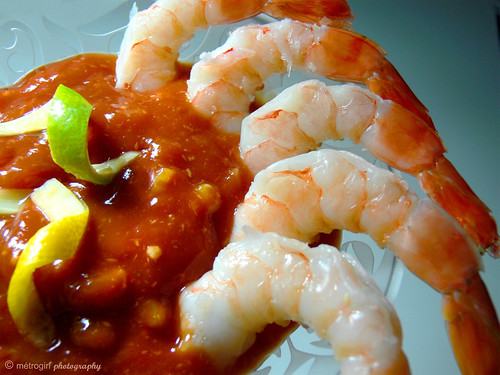
Just an small side note on the glass design…
I wanted to share some information on these etched crystal martini glasses that I used in the styling of these shrimp images.
They are pricey beyond what I could ever afford.
But they I acquired them as ‘a major award’ that I won in an architectural design contest. I treasure them more for the award than for their inherent worth, but I love that they give beautiful food a lovely backdrop.
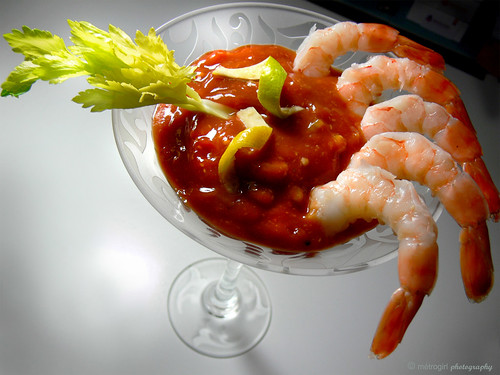
These original hand-etched and signed glasses were designed by the talented artist, Michael Weems, who has worked extensively with Gucci and Tiffany.
I find them so serviceable for many purposes yet simply stunning on their own.
They are usually sold in sets of all one color, but for the award I received one in each of the six colors in this artist’s design palate…
white (clear), lime, wine, cobalt, aquamarine and rosé (pink).
I just wanted to share their singular beauty and this talented designer’s work with all of you, my dear readers.
How do you like to eat Shrimp and tomatoes in these last warm days of summer…?
Friday, August 15, 2008
Adventures with the tomato…Part III Pomme d'amour…romancing the tomato…
tomatoes grown in Europe and were called ‘love apples'.
They were named as such because they were related botanically to the mandrake, or ‘love plant’, which was noted in the Bible for its reputed aphrodisiac qualities.
In 1553, Swiss naturalist Konrad Gessner depicted the small-fruited love apple in a watercolor, and identified it in Latin as ‘poma amoris’.
Pomme d'Amour (French for ‘love apple’) is similar to these small-fruit tomatoes that were mostly grown for ornament.
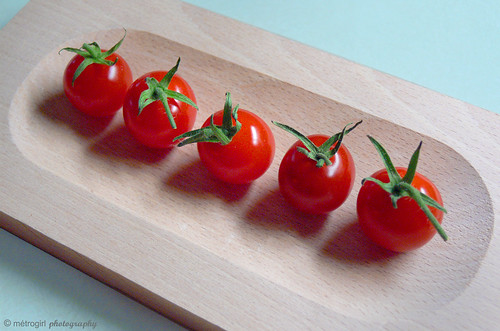
One of the strangest things about the history of the tomato is the fact that, although it is of American origin, it was unknown as food in this country until long after it was commonly eaten in Europe. Until hardly more than a hundred years ago it was generally thought to be poisonous in the United States.
Most Americans thought that the tomato was poisonous because of the way plates and flatware was made. Well to do families in that time used flatware made of pewter, which has a high-lead content. Foods high in acid, like tomatoes, would cause the lead to leech out into the food, often resulting in lead poisoning and death.
The poorer people in the 1800’s, who ate off of plates made of wood, did not have that problem, and hence did not have an aversion to tomatoes.
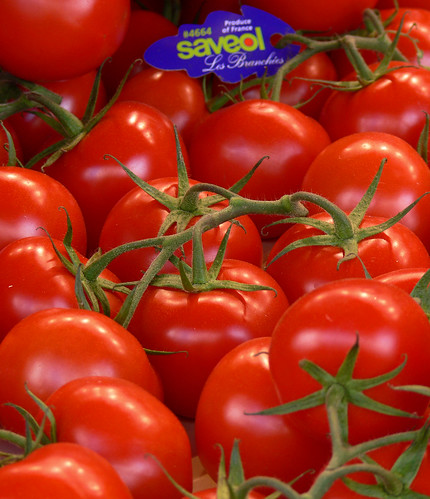
What changed to make the tomato a popular food...?
The most significant event was the mass immigration from Europe to America in the 1800’s and the traditional blending of cultures.
Most Italian-Americans ate tomatoes and brought that food with them.
Perhaps equally as important, was the invention of the pizza.
There is no pizza without tomatoes, and pizza was conceived
near Naples in the late 1880's.
As the story is told, pizza was created by a restaurateur in Naples to
celebrate the visit of Queen Margarite. The restaurateur made the pizza from three ingredients that represented the colors of the new Italian flag: red, white, and green.
The red is the tomato, the white was the mozzarella cheese, and the green was the basil. Hence, Pizza Margarite was born, and is still the standard for pizza.
What could have led more to the popularity of the tomato than pizza?
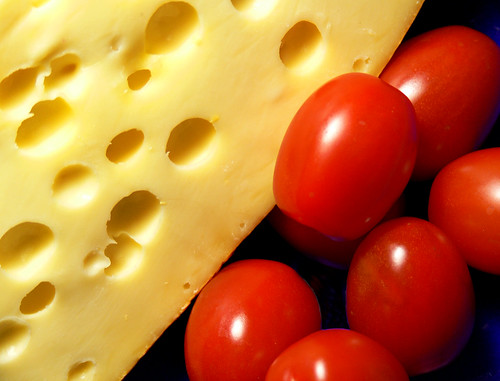
Thomas Jefferson was a pioneer in tomato culture.
He documented planting this relatively unfamiliar vegetable in his kitchen garden beginning in 1809, until his death in 1826.
In his notes on the State of Virginia, 1782, Jefferson noted that tomatoes were grown in his Virginia gardens at Monticello.
These mild, sweet, red tomatoes are ideal for garden snacking, salads, and drying.
This tomato pictured below was a plant that I grew from seeds that I obtained at Jefferson’s home in Monticello, VA.
 The tomato was not regarded as an indispensable kitchen ingredient in the United States until the times preceding The Civil War Period. From that point forward, tomatoes have become a staple item in kitchens throughout the world.
The tomato was not regarded as an indispensable kitchen ingredient in the United States until the times preceding The Civil War Period. From that point forward, tomatoes have become a staple item in kitchens throughout the world.Each area of the world has its own tomato history and how it is used in everyday dining. It appears as though tomatoes have had the largest impact on American eating habits, as they are responsible for consuming over 12 million tons of tomatoes each year.
That is “a whole lot of love”…!
Wednesday, August 13, 2008
Adventures with the tomato...Part II...San Marzano Tomatoes…Parlate Italiano…?
The volcanic soil is believed to act as a filter for water impurities. Compared to the Roma Tomatoes with which most people are familiar, Marzano tomatoes are thinner and pointier in shape. The flesh is much thicker with fewer seeds, and the taste is much stronger, less sweet and less acidic. Many people describe the taste as bittersweet, like high-quality chocolate.

Because of their high quality and origins near Naples, San Marzano tomatoes have been designated as the only tomatoes that can be used for Vera Pizza Napoletana (true Neapolitan pizza).
Through commercial production of the San Marzano variety is most closely associated with Italy, seeds for the variety are available worldwide, often labeled as an heirloom variety, frequently imported from Italy, and sold at a premium over more common varieties. The San Marzano vines are indeterminate and have a somewhat longer season than other paste tomato varieties, making them more suitable for warmer climates.

The name denotes both a point of origin and a variety of tomato. Canned Marzano Tomatoes are grown in Italy in compliance with Italian law will have the EU and DOP emblem on the label.
As is typical of heirloom plants, San Marzano is an open-pollinated variety that breeds true from generation to generation, making seed saving practical for the home gardener or farmer.
I wanted to shares the history of this succulent and delicious native Italian fruit with all of you. I also wanted to remind after our tomato season is over,
there is no reason to settle for pale tasteless tomatoes in your autumn and winter salads.
These delicious tomatoes will crown any cold winter weather salad with Neapolitan sunshine.
Adventures with the tomato…Part I

Those of you reading this that have followed my Flickr images over the years already know that I am obsessed with the tomato. I love to grown them, cook with them, eat them right off the vine and in any recipe.
I love this quote from Alice May Brock (of Alice's Restaurant fame):
Tomatoes…
Oregano makes it Italian;
Wine and tarragon makes it French.
Sour cream makes it Russian;
lemon and cinnamon make it Greek.
Soy sauce makes it Chinese;
garlic makes it good…!
For years I have not been able to stop myself from photographing tomatoes.
The seductive form of my favorite perfectly oval, perfectly red, perfectly sweet grape tomato is always too much to resist.
And those heirloom varieties with their coats of many colors and often abstract shapes are like miniature Picasso sculptures on the vine.
And in my wackier moments, I have even concocted stories about adventures of a certain tiny tomato named, Tom...(but, of course…!)

Lately, I have had a hunger to read all that I can find about this versatile fruit (yes, for those of you that don’t already know, the tomato is technically a fruit).
This was always an interesting aspect of tomato history to me, and there has been a long standing debate of ’Fruit or Vegetable’ question.
By definition, a fruit is the edible plant structure of a mature ovary of a flowering plant, usually eaten raw; some are sweet like apples, but the ones that are not sweet such as tomatoes, cucumbers, peppers, etc. are commonly called vegetables.
Botanists claim that a fruit is any fleshy material that covers a seed or seeds.
Yet horticulturists would pose that the tomato is a vegetable plant.
Until the late 1800's the tomato was classified as a fruit to avoid taxation, but this was changed after a Supreme Court ruling that the tomato is a vegetable and should be taxed accordingly.
Well, with whatever you wish to call him, I call the history and lore surrounding the tomato, darn interesting reading.
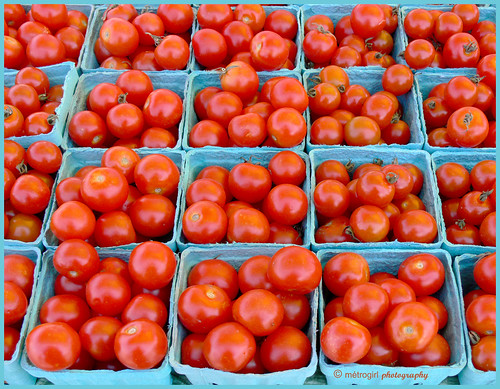
Lycopene is the pigment that makes certain fruits and vegetables red, such as tomatoes, watermelon, guava and pink grapefruit. Lycopene is an antioxidant which may help lower the risk of certain diseases. In the body, lycopene is deposited in the liver, lungs, prostate gland, colon and skin.
Its concentration in body tissues tends to be higher than all other carotenoids. But of all the carotenoids, lycopene is one of the most potent antioxidants. And studies have shown that high consumption of lycopene rich vegetables is associated with a lower risk of certain types of cancer.
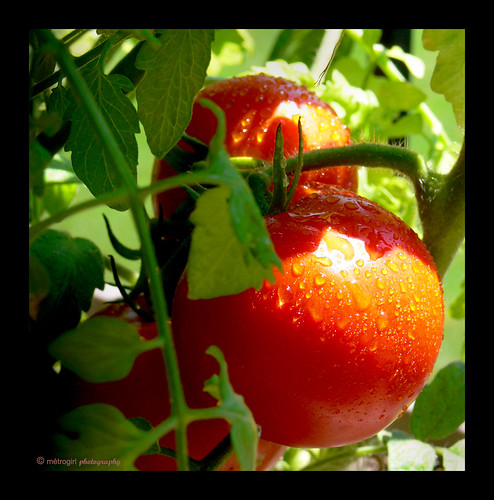
Lycopene is not produced by the body, so you can only obtain its benefits through eating lycopene rich foods. Tomato based products are particularly good sources.
Products such as tomato rich pasta sauces, tomato based soups, tomato juice, tomato sauce and tomato paste are common sources of lycopene in the diet.
Besides their delicious-ness, this health benefit is another solid reason to eat those glorious home-grown tomatoes that are in season right now.
I was going to add a favorite tomato recipe here, but the best way I know to eat tomatoes at this time of year is sliced with a pinch of whatever salt suits my fancy that day. Today I had a glorious beefsteak tomato with a dash of Kilauea black sea salt.
Perfect...!
What is your favorite way to eat a fresh tomato…?
Tuesday, August 12, 2008
Saving summer sunshine...
ripe or near ripe and available from local sources.
On an almost a daily basis, I have been making the rounds of my favorite farmers markets and farm stands. I am always excited to see the new crops of just picked fruits (and veggies) that appear on the stands from the nearby farms.
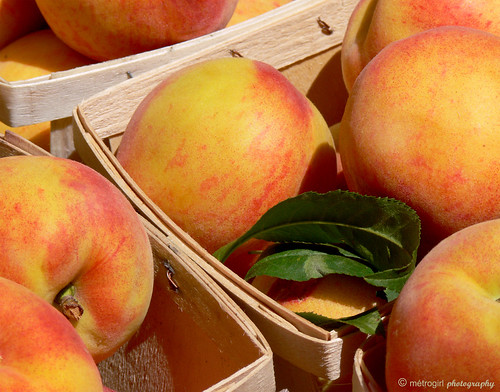
It occurred to me that I was saving the pixels of summer as I had saved the warm juicy peaches, apricots and cherries in my favorite summer fruit compote.
It also occurred to me that I had better share the recipe for this compote with you right away so you can save your own sparkling glass jar full of summer and capture the luscious flavors before they disappear until next year.

My Favorite Summer Fruits Compote
4 fresh white peaches, pitted and sliced
6-8 fresh apricots, pitted and sliced in quarters
A handful of fresh Rainier cherries, pitted and halved
1 cup water
1 tablespoon sugar (or to taste)
The juice of one lemon and one lime
1/2 teaspoon good vanilla
Pinch of sea salt or Kosher salt
(For a spiced version, I add 1/4 teaspoon freshly grated Nutmeg and
1 teaspoon Cinnamon, or to taste…)
In a non-reactive saucepan, combine citrus juices and water and
put in the fruits as you pit and slice them to prevent the fruit
from turning brown.
I like to take some of the skins off the white peaches and leave
some of them with skins.
I do this as it adds variety of color and texture
to the finished compote. Also the leaving some
of the skins in place allows the natural pectin to thicken the
compote.
Add sugar, vanilla and pinch of sea salt and combine.
Place over medium heat, stirring constantly until the
sauce bubbles gently. Lower heat and simmer for about 20-30
minutes stirring frequently until the volume of the fruit is reduced
by about half and the liquid thickens to the consistency of honey.

I love to serve this compote gently warmed over vanilla bean ice cream or frozen yogurt for dessert.
But the spicy compote is a great accompaniment to a grilled pork or lamb dinner.
Best of all, a spoon of this compote on seven grain toast for breakfast will warm the chill of a autumn morning.
Store in refrigerator in air tight container, preferably glass,
(that is, if there is any left to store…!)
Bon Appetit...!
Friday, August 8, 2008
Feasting...on pixels
edible imagery of food...!
I adore the aromas of fresh herbs I clip from the plants on my terrace garden.
I love the way their glorious scent lingers on my hands.
I add them to a red sauce set to simmer and they continue to swirl and perfume my home.
I love the sassy, pungent red and green peppers I pick just outside my door.
Their glossy skins and sensual shapes seem to smile as I chop them into a fresh salsa.
I tend to swoon over the ethereal perfume of sweet white peaches and Rainier cherries as I turn them into a peach and cherry compote.
Their preservation in a cheerful glass jar will infuse light and sweetness into future dark winter mornings.
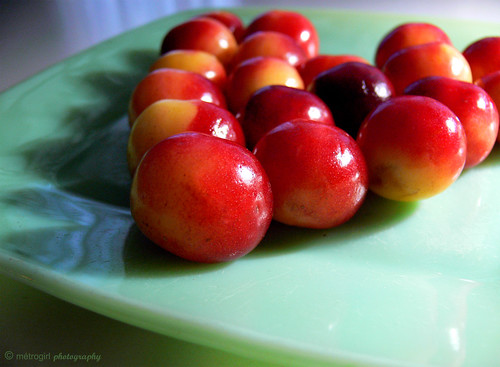 But more passionately, I love to photograph food…!
But more passionately, I love to photograph food…!To me, there is something amazing about capturing a delicate and fleeting moment in the life of a perfect handful of cherries or the artful presentation of a chef’s special creation that is totally irresistible to me.
For a long time, I have desired to improve and become more skilled at producing beautiful images of food. I sought to experiment with new ways to photograph the deliciousness if only, at times just to catalog the experience of the food for myself. But that seemed a bit self-serving and was not inspiring me to the dedication and discipline I need to progress and define my 'voice' as a food photographer.
 I love to eat what is fresh and in season, that is the type of food I enjoy the most.
I love to eat what is fresh and in season, that is the type of food I enjoy the most.But I am always very interested to try a new dish, a new technique or a new spin on a time honored cuisine. I love to know about the food I eat...where it comes from, where it was grown, who are the people that grew it or raised it or how it is made.
Does it reflect its place of origin?
How did it come about to look the way it does today from a gastronomic, scientific or historical perspective?
I spend a great deal of time each and every day (perhaps too much)reading about food.
I love to read what is written by people that are as passionate about it as I am.
I posses hundreds of books on food; food science, nutritional anthropology, way too many cookbooks, restaurant histories, "Molecular gastronomy" and food trivia all spilling out of my over-loaded bookcases.
My culinary inspirations have long been Julia Child, but also Paul Bocuse, Patricia Wells, M.K.Fisher, Alice Waters, Alton Brown, Ferran Adria and many, many more.
I also love to shop for food, especially in the fresh in the Farmer's Markets that are near my homes in Chicago and especially in Paris.
From May to October you can find me in the outdoor markets and marchés photographing the beauty of a fresh picked crop, talking to the growers and buying as many fruits and veggies as I can carry to my house or appartement.

I wanted the you, my visitors, to be able to taste the essence and personality of the
food that I capture on these digital pixels.
There was no “perfect time” to begin a blog.
But I needed to begin...
I present to you what I am: an out of work architect, interior designer, former ER -RN,
free-lance photographer, abstract artist and life-long foodie...
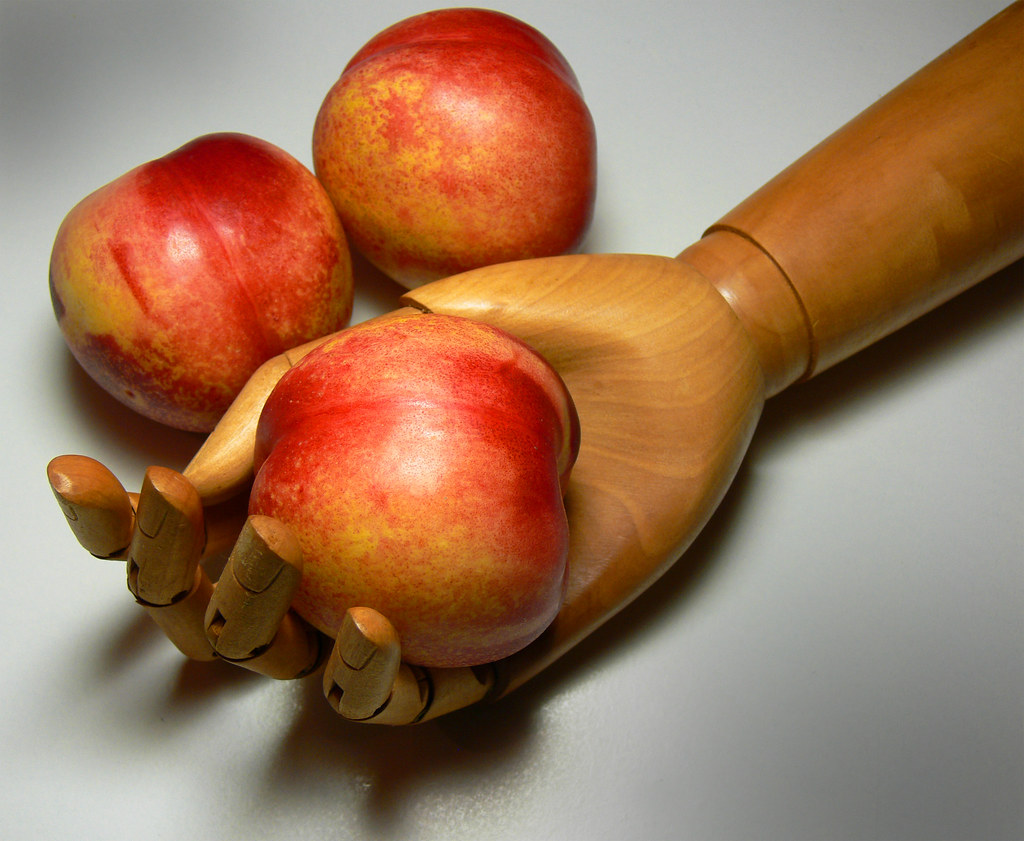
Under a lovely shade tree near the pond outside my door, I am spreading a clean, but worn linen cloth on a impossibly long table.
On that table am setting out my images and thoughts as an optimistically joyful and delicious smorgasbord for you to enjoy.
I hope that you, my visitor, will approach without fearand taste this feast I offer you. I will be gathering all the delicious beauty I see for your enjoyment.
Today, as the torch is lit for the the XXIX Olympiad, I begin my quest,as well.
It is with some trepidation, but with great enthusiasm that I begin this blog.
Welcome to Feasting...on Pixels.



